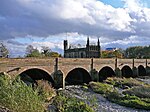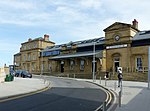Belle Vue (Wakefield)
Buildings and structures in WakefieldCommons category link is locally definedFootball venues in EnglandRugby league stadiums in EnglandSports venues in West Yorkshire ... and 2 more
Use British English from September 2015Wakefield Trinity

Belle Vue, also known as the DIY Kitchens Stadium for sponsorship reasons, in Wakefield, England, is the home of Rugby League club Wakefield Trinity RLFC and Association Football club Wakefield A.F.C. It is on the A638 Doncaster Road, a mile south of Wakefield city centre.
Excerpt from the Wikipedia article Belle Vue (Wakefield) (License: CC BY-SA 3.0, Authors, Images).Belle Vue (Wakefield)
Arthur Street, Wakefield Belle Vue
Geographical coordinates (GPS) Address Nearby Places Show on map
Geographical coordinates (GPS)
| Latitude | Longitude |
|---|---|
| N 53.669722222222 ° | E -1.4794444444444 ° |
Address
Arthur Street
WF1 5HU Wakefield, Belle Vue
England, United Kingdom
Open on Google Maps











